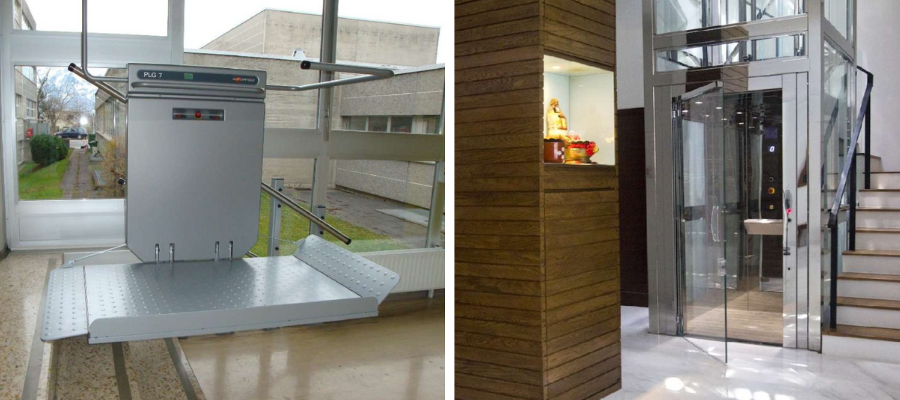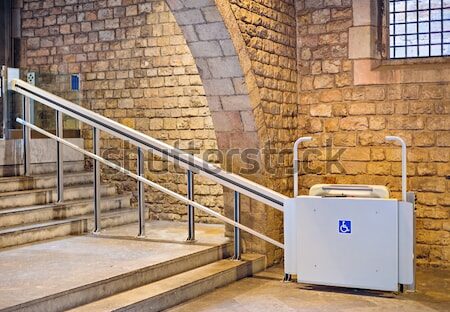Which is best for disabled access in my building?
With multiple lifts on the market, we understand that it can be difficult to select the best one for you.
In this blog, we’ll look at inclined platform lifts and cabin lifts, exploring their benefits and which might be best suited to disabled access on your property.
What’s an inclined platform lift?
As the name suggests, an inclined platform lift is a flat platform that travels along an incline stair rail system.
These specialist lifts are installed indoors and outdoors, designed to provide wheelchair users with safe access between floors.
Safety is ensured with non-slip flooring and supportive barriers that rise when the lift is in use, preventing wheelchairs from falling.
Why are inclined platform lifts installed?
Inclined lifts are installed for various reasons:
1. When a raised area is too high for safe wheelchair access. This includes entrances to raised buildings.
2. At locations where a ramp wouldn’t be practical. For example, in older buildings or schools with narrow corridors and staired inclines.
3. In low-rise buildings where installing a cabin lift is unnecessary.
A straight rail inclined platform lift operates along a rail without curvature, while the curved rail lifts are used on rail systems with a change in gradient.
The benefits of an inclined platform lift
There are plenty of advantages to installing an inclined wheelchair lift.
1. Users retain independence
These machines help disabled people retain their independence.
In areas or buildings with no access lift, those who can’t leave their wheelchairs are confined to one floor, making them heavily reliant on carers.
An inclined platform lift enables wheelchair users to move up and down floors without assistance.
2. Health and safety
Carers can struggle to lift their patients onto stairlifts or up flights of stairs and doing so can be bad for their backs, leading to possible injury.
An inclined lift is a safer and more dignified method that prevents accidents on staircases.
3. Require little space to install
An inclined wheelchair lift only requires a rail to operate and can be folded, creating space for others on the stairwell.
This also makes inclined platform lifts ideal for retrofitting existing buildings to make them wheelchair accessible.
4. They’re affordable
Although prices vary between manufacturers and depend on how far the lift needs to reach, inclined platform lifts are generally more affordable than other access lifts and don’t require a lift shaft, which is expensive and timely to install.

What’s a cabin lift?
Traditionally found in high-rise buildings such as hotels and department stores, cabin lifts consist of an enclosed passenger car with opening and shutting doors.
Unlike platform stair lifts, they move up and down vertically within a lift shaft, which houses the cabin and lift mechanism.
Cabin lifts typically carry up to 400kg, equal to eight people at a time and have plenty of space for wheelchair access.
Although costs vary depending on the type of cabin lift, the manufacturer, and size, they are typically more expensive than inclined platform lifts.
What are the benefits of a cabin lift?
Although not designed solely with disabled access in mind, cabin lifts are used by wheelchair users in public and residential spaces. And they can offer a wide range of benefits.
1. Speed
Our cabin lifts travel up to 0.15m/s as set out in The Supply of Machinery (Safety) Regulations 2008 depending on the manufacturer. This is much faster than inclined lifts.
2. Discrete appearances
Their interior and mechanisms are enclosed behind shutting doors, making cabin lifts highly discrete whilst still being able to provide disabled access.
Modern lifts can even be designed to match décor and are considered a bold style feature.
3. Spacious interiors
Cabin lifts are wider, having space for wheelchair users, carers, and other passengers as well as luggage and bags.
Do I need an inclined platform lift or a cabin lift?
When selecting a lift, you should consider its purpose, your budget, and the building you intend to install it into
In low-rise buildings, where moving between floors is only an issue for wheelchair users, a platform lift is more practical.
Inclined platform lifts are also more affordable and only require a stair rail to operate on, making them better suited to retrofitting.
For high-rise buildings with over four floors, cabin lifts are better suited.
Although they’re more expensive and require a lift shaft, these lifts enable faster transportation between floors, making them perfect for busy areas.
Enable easy access for all
Residential buildings, businesses, and public facilities must provide easy wheelchair access to all property levels.
Without it, disabled people lose their independence and cannot safely manoeuvre around the building, putting themselves and their carers at unnecessary risk.
Invest in a lift today
At Level Access Lifts, we’re dedicated to supplying our customers with the best lift for their needs. Whether it be an inclined platform lift or cabin lift, our experts are on hand to advise you and provide a sturdy, premium lift.

